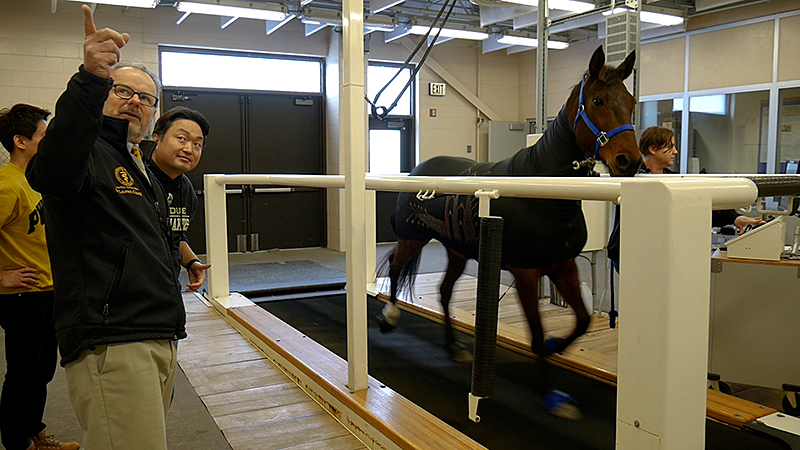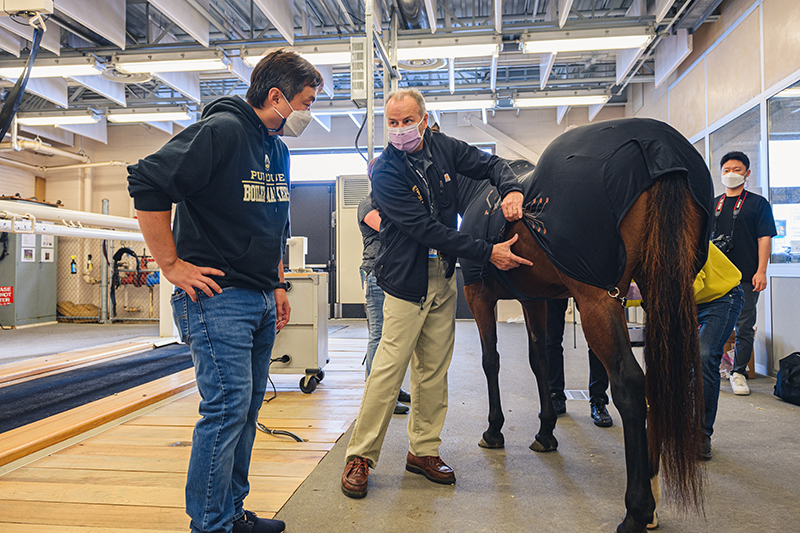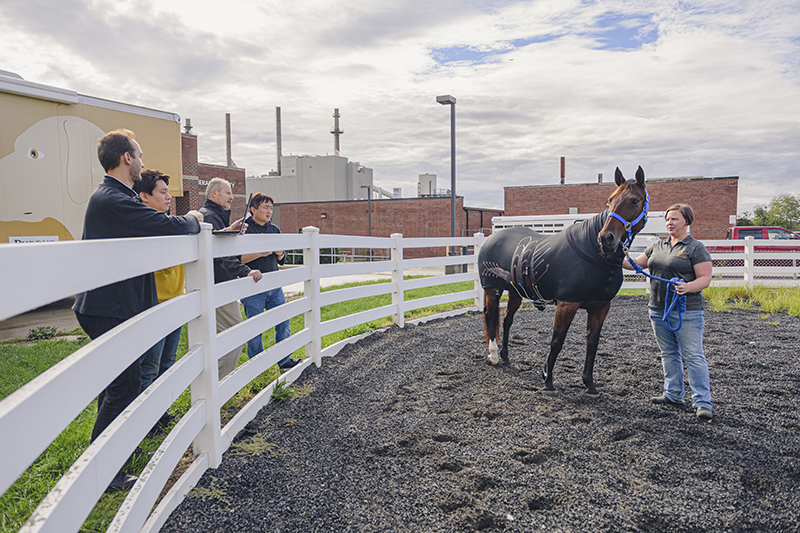April 4, 2022
How do you test for equine asthma and heart disease using a remote horse slicker? Put the horse on a treadmill.

Purdue University biomedical engineers and veterinarians have developed a remote horse slicker that can be used to monitor a horse’s respiratory, cardiac and muscular systems. The horse slicker is being tested by a horse on a treadmill. (Purdue University photo).
WEST LAFAYETTE, Ind. —Asthma, heart disease or muscular issues can derail any athlete’s season – even racehorses who run at local tracks or have their sights set for horse racing’s Triple Crown.
Now, Purdue University biomedical engineers and veterinarians have developed a new remote horse slicker that can monitor a horse’s cardiac, respiratory and muscular systems via Bluetooth technology. The e-textile can be useful for long-term management of chronic health conditions in large animals, with the goal to have a version for human use.
Another perk of the e-textile is that veterinarians and their support staff won’t have to shave the horse’s hair or use messy adhesives to place the electrode on the horse’s skin, which makes it more comfortable for the horse. (Watch some video of the slicker being used by a horse on a treadmill here.)
 Laurent Couëtil (right) talks about horse cardiac, respiratory and muscular systems with Chi Hwan Lee (left), the Leslie A. Geddes associate professor in Purdue University’s Weldon School of Biomedical Engineering. Couëtil, professor in Purdue’s College of Veterinary Medicine, is a collaborator with Lee on a horse slicker designed to remotely monitor chronic health diseases in horses. (Purdue University photo/Rebecca McElhoe)
Download image
Laurent Couëtil (right) talks about horse cardiac, respiratory and muscular systems with Chi Hwan Lee (left), the Leslie A. Geddes associate professor in Purdue University’s Weldon School of Biomedical Engineering. Couëtil, professor in Purdue’s College of Veterinary Medicine, is a collaborator with Lee on a horse slicker designed to remotely monitor chronic health diseases in horses. (Purdue University photo/Rebecca McElhoe)
Download image
Findings of how the e-textile works is featured in a study published in the journal Advanced Materials.
Chi Hwan Lee, the Leslie A. Geddes associate professor of biomedical engineering in Purdue’s Weldon School of Biomedical Engineering, said the Purdue team developed a dual regime spray and technique to directly embed a pre-programmed pattern of functional nanomaterials into the slicker’s fabrics to add the e-textile capabilities to the slicker. Lee also has a joint appointment in the School of Mechanical Engineering and a courtesy appointment in the School of Materials Engineering.
According to Lee, adding e-textile properties to existing garments helps scientists, researchers and clinicians take advantage of the garments’ already-existing ergonomic designs to secure a commercial grade of wearability, comfortability, air permeability and machine washability.
“These specially designed e-textiles can comfortably fit to the body of humans or large animals under ambulatory conditions to collect bio-signals from the skin such as heart activity from the chest, muscle activity from the limbs, respiration rate from the abdomen or other vital signs in an extremely slight manner,” Lee said. “Our technology will significantly extend the utility of e-textiles into many applications in clinical settings.” (Hear more from Lee on the technology and how it will improve equine health here.)
The team’s next steps involve developing continuous 24-hour monitoring of horses with chronic disease or those receiving care in a veterinary ICU.
“We believe that our technology will be helpful in diagnosis or management of chronic diseases,” Lee said, especially as demand increases for remote health monitoring.
 Professors Chi Hwan Lee (right) and Laurent Couëtil chat while observing a cardiac, respiratory and muscular test on a horse named Leila at Purdue University’s College of Veterinary Medicine. Graduate students Semih Akin (left) and Taehoo Chang capture the horse’s vital signs on a laptop via Bluetooth technology from a specially designed horse slicker. Laura Murray, research technologist in the College of Veterinary Medicine, is with Leila. (Purdue University photo/Rebecca McElhoe)
Download image
Professors Chi Hwan Lee (right) and Laurent Couëtil chat while observing a cardiac, respiratory and muscular test on a horse named Leila at Purdue University’s College of Veterinary Medicine. Graduate students Semih Akin (left) and Taehoo Chang capture the horse’s vital signs on a laptop via Bluetooth technology from a specially designed horse slicker. Laura Murray, research technologist in the College of Veterinary Medicine, is with Leila. (Purdue University photo/Rebecca McElhoe)
Download image
“Remote health monitoring under ambulatory conditions would be useful for farm and household animals, as it could potentially minimize clinic visits, especially in rural areas. It would also increase the efficiency in managing a large number of farm/household animals at once from a distance, even overnight,” Lee said.
A real-life example would be the ability to monitor severe equine asthma, which affects 14% of adult horses.
“Continuous monitoring would allow early detection of disease flair-up before it gets serious, offering an opportunity to nip it in the bud,” said Laurent Couëtil, a professor of large animal internal medicine in Purdue’s College of Veterinary Medicine and collaborator in the study. “Remote monitoring opens the possibility of sending vital information to the veterinarian to help make timely and informed treatment decisions.”
The Purdue research team also included Martin Byung-Guk Jun, an associate professor of mechanical engineering in the School of Mechanical Engineering; Taehoo Chang of the School of Materials Engineering; Semih Akin, Bongjoong Kim and Sengul Teke of the School of Mechanical Engineering; Laura Murray of the College of Veterinary Medicine; and Seungse Cho, Sena Huh and Min Ku Kim of the Weldon School of Biomedical Engineering.
The Purdue Research Foundation Office of Technology Commercialization has filed a patent for the technology. Funding came from the National Institutes of Health National Institute of Biomedical Imaging and Bioengineering (1R21EB026099-01A1), the National Science Foundation Civil, Mechanical and Manufacturing Innovation (1928784) and the SMART Films Consortium in Purdue’s Birck Nanotechnology Center, located in Discovery Park.
This work is part of Lee’s focus in developing platform technologies using sticktronics, which are sticker-like items that contain electronics or smart technology. Sticktronics offer the ability to physically separate supporting substrates in existing electronic items and turn an item into a sticker that can be more flexible or transparent, especially on curved displays and biomedical sensors. Lee also specializes in custom-printed soft medical sensors and conformable sensor arrays, all of which can transform telemedicine and on-demand drug delivery systems.
More Purdue Biomedical Engineering Innovations
Small cyberphysical watermarks could prevent huge headaches caused by fake meds
Enhancing ordinary items for addressing health outcomes
Cracking the code of cellular defense
About Purdue University
Purdue University is a top public research institution developing practical solutions to today’s toughest challenges. Ranked in each of the last four years as one of the 10 Most Innovative universities in the United States by U.S. News & World Report, Purdue delivers world-changing research and out-of-this-world discovery. Committed to hands-on and online, real-world learning, Purdue offers a transformative education to all. Committed to affordability and accessibility, Purdue has frozen tuition and most fees at 2012-13 levels, enabling more students than ever to graduate debt-free. See how Purdue never stops in the persistent pursuit of the next giant leap at https://stories.purdue.edu
Media contact: Matthew Oates, 765-586-7496 (cell); oatesw@purdue.edu; @mo_oates
Sources: Chi Hwan Lee, lee2270@purdue.edu
Laurent Couëtil, couetill@purdue.edu
Taehoo Chang, chang466@purdue.edu
Note to journalists: B-roll of the remote horse slicker being used by a horse on a treadmill and an audio clip of Chi Hwan Lee is available via Google Drive. Visitors to campus should follow standards set in Protect Purdue guidelines.

